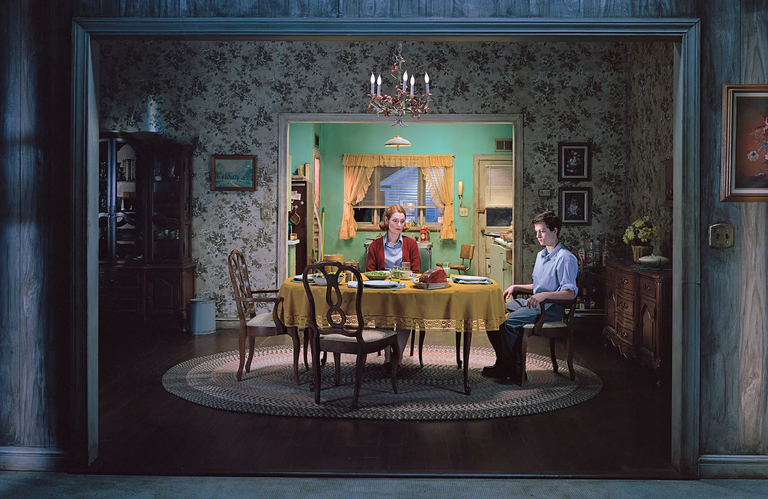Dinner Table Truths
Continuing with my exploration of the photographic works of Gregory Crewdson, for this post I am focusing on a picture he captured back in 2003 for his Beneath the Roses series.

If we look at the picture we are presented with a solemn and sorrowful image. Despite the facial expressions on both woman and boy being somewhat vague and ambiguous they still seem to somehow communicate the most vivid of expressions. The characters seem lost even though they appear to be sitting in the comforts of their own dining room, in their own house, in what should be very familiar territory and maybe it is but perhaps it is each other they don’t know so well, maybe they are too distant from one another to be comfortable.
They are more than just fed up, the woman seems at the end of her tether almost in despair. There is an absence to, if the picture does depict a mother and son at dinner time then where is the father? Is he still at work? Is he away from home on a business trip? Has he left his family behind for good? Or worse? And is the absence of the father the explanation for the distance between the two remaining family members? There is the sense that something is missing and this sense is very strong and impacts on the two characters greatly. It is yet another Crewdson image that generates so much curiosity.
In his photos Crewdson is exploring the concept of the ideal world and contrasts this with the real world. The pictures are expressing a clear curve of emotion and this is being achieved through the character’s facial expressions and their body language which are subtly but very successfully communicating this emotion. In terms of formalism then much of Crewdson’s work would be deemed an irrelevance as regards aesthetics and subject to less meaningful critical attention as it would not show an interest in emotion, narrative or contrived characters. However the lack of definition from formalism’s founders Roger Fry and Clive Bell in the 1920’s who were unable to clarify the criteria for formalism does not therefore support an overly helpful theoretical paradigm to explain Crewdson’s work
Much of the emotion in Crewdson’s work seems to speak of an unhappiness, this is a theme that penetrates many of his photographs. The emotional current that runs through this theme of unhappiness belongs to various sources, and those sources engenders various emotions. The emotion constituent of his work is not too intense although it’s more than delicate, it’s strong but not serious enough to signify trauma although there is certainly turmoil. There’s loneliness, longing, pining, yearning, desperation, sadness, melancholy, regret, remorse and yet despite all this negativity there is somehow still hope and through that hope comes a warmth to the pictures, you simply do not get the sense that all is lost.
Congratulations @peaceandmoney! You have completed the following achievement on the Hive blockchain And have been rewarded with New badge(s)
Your next target is to reach 300 replies.
You can view your badges on your board and compare yourself to others in the Ranking
If you no longer want to receive notifications, reply to this comment with the word
STOPCheck out our last posts:
A pollinator from The Pollen Nation feels this post deserves extra attention!
We appreciate your contribution to the blockchain.
For more information or to reach out to us, join our Discord server!